Plus a possible explanation for how she was injured.
Three days ago on Christmas morning I spent some more time with the immature presumed female Red-tailed Hawk with an injured leg or foot that I’ve documented in two previous posts. Like me many of my readers have become very interested in her welfare so today I’m posting a very large number of photos of her taken prior to and during a takeoff that document how she is and isn’t using her injured extremity. Many of my readers including rehabbers, falconers and others have significant experience with injured raptors so I’m hoping for some feedback and insight regarding her health status and potential progress.
A few notes and caveats about the series below:
- At the beginning of the series she was perched on a utility pole at Farmington Bay WMA. She took off after a vole she spotted at the base of a nearby outhouse.
- For some mysterious reason I had difficulty getting sharp shots of her so many of the photos in the series are slightly or moderately soft. But they’re plenty sharp enough for documentary purposes.
- The photos largely speak for themselves so I’ll keep my narration to a minimum until the end of the series when I’ll add some of my own thoughts and observations.
- I’m including 21 photos, a new record for Feathered Photography. All but two, the first and the last, are consecutive shots in a burst lasting exactly 1.9 seconds.
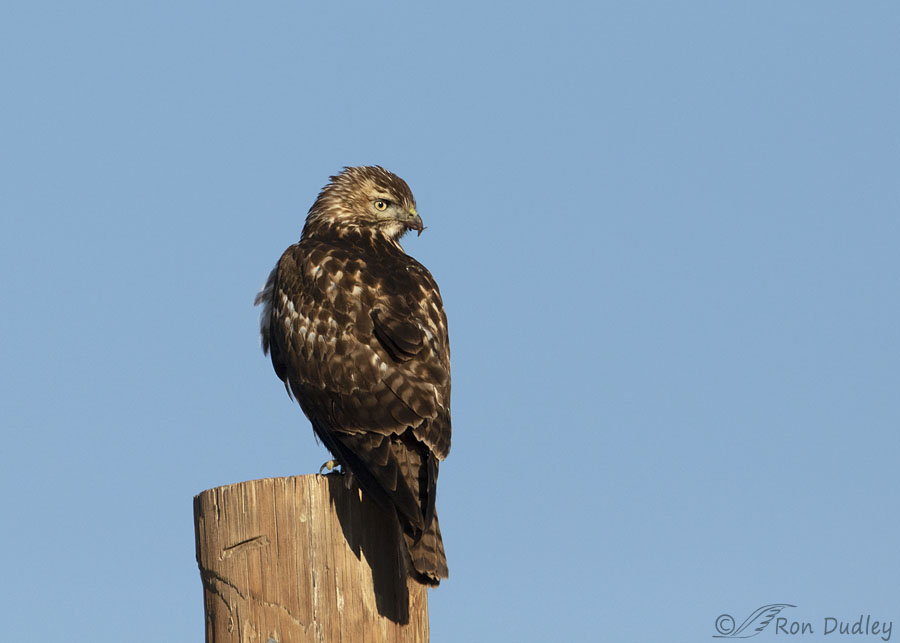
Just prior to this first shot she’d been facing to my left but here she glanced back at the base of the outhouse.
It almost looks like she has a crossed bill but she doesn’t. In other shots of her I could see that she had lots of blood and vole bits on the left side of her bill and that’s what we’re seeing here. Thankfully she’s apparently eating well.
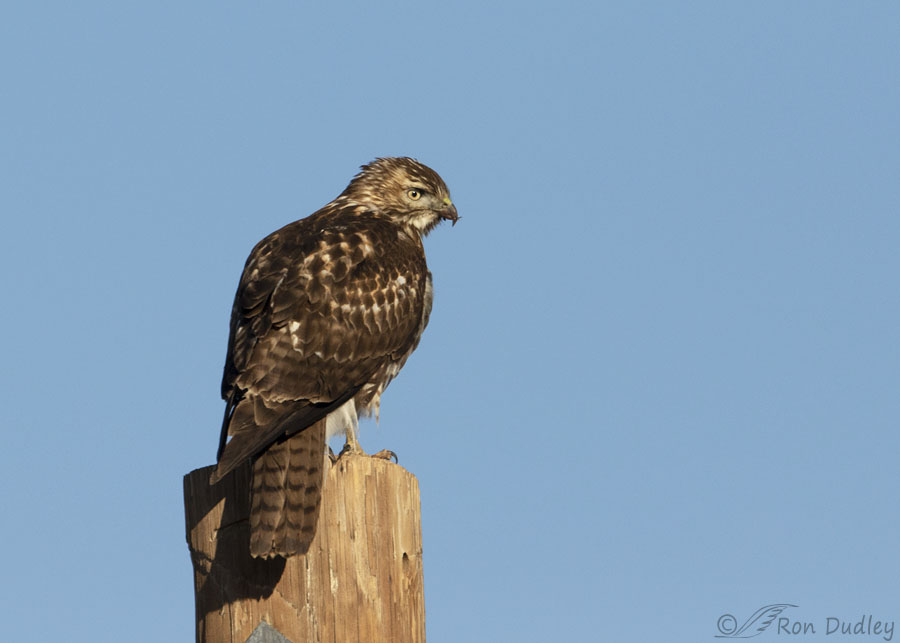
I could tell from her demeanor that she’d probably spotted potential prey so my burst began with this photo. Her injured leg/foot is her left one. All we can see of that foot here is the talon on her hallux (rear toe). Keep an eye on her left foot and hallux as we progress through the series. I think how she uses and doesn’t use them prior to and during takeoff is relevant to her injury.

Notice that as she turned her body to face the vole she kept her feet in place which resulted in a cross-legged posture that she…

maintained even after…

she had turned…
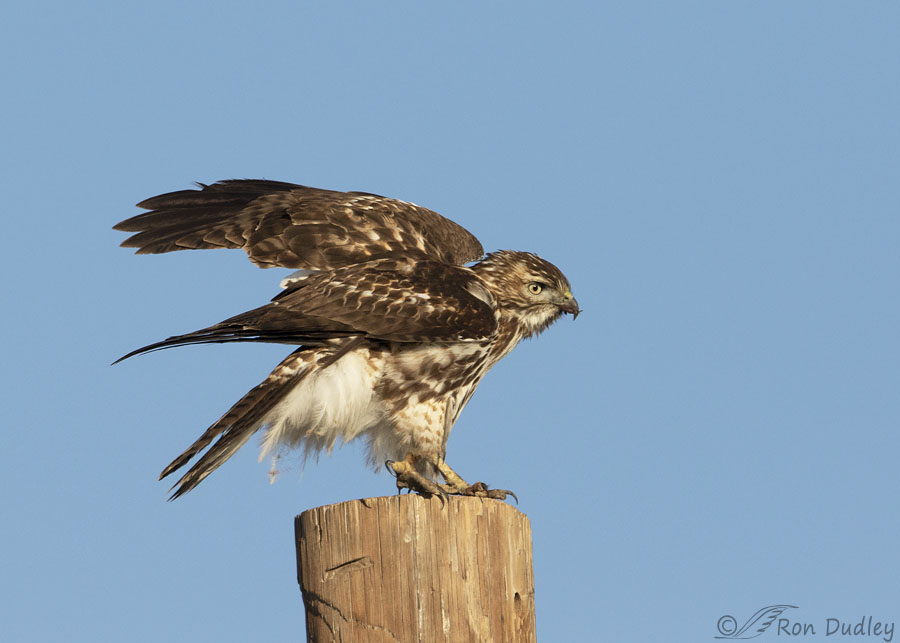
almost…

180°.

.





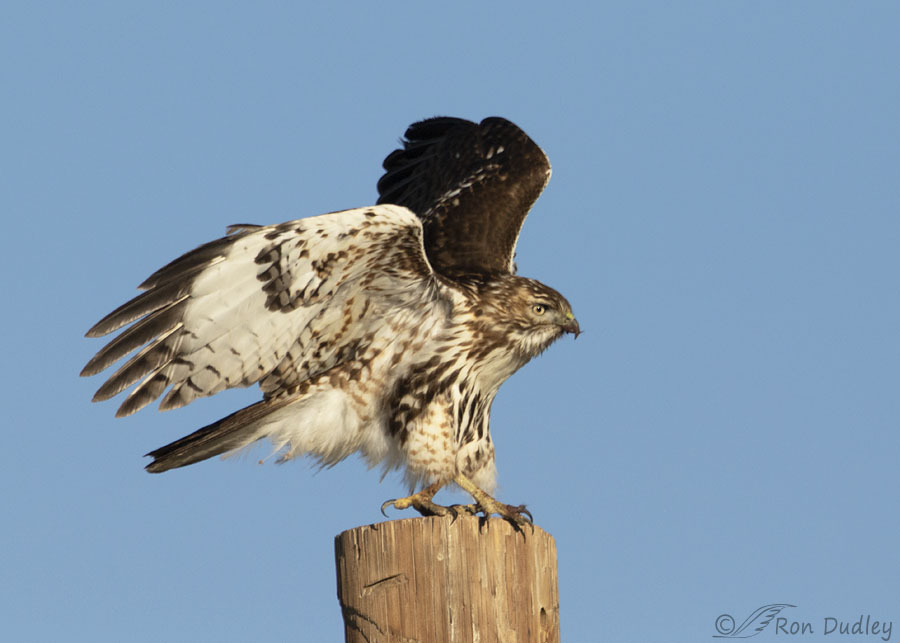

Have you been noticing that she kept the tip of her left hallux talon off of the perch throughout the process? In a few photos it was close to touching the perch but I don’t believe it ever actually did. Even in this shot where she’d raised her uninjured foot and had most of her weight on the front three toes of her injured foot she kept her hallux entirely off of the perch.

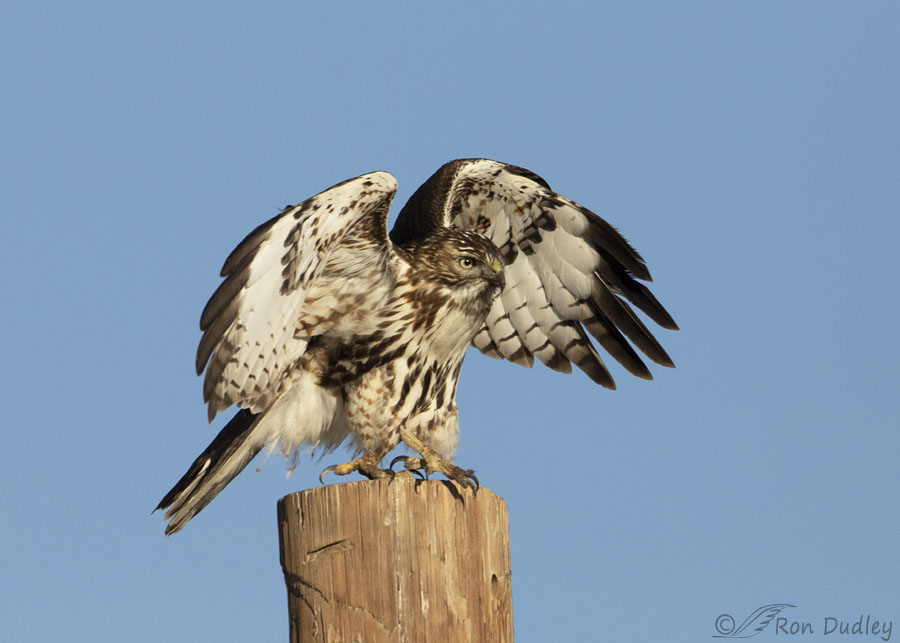


Finally, she’s ready to take off after the vole. Here she’s about to push off with both her uninjured right leg and the front three toes of her injured left foot/leg.

Airborne.
I can’t be sure but I believe she captured the vole at the base of the outhouse. When she landed in a nearby tree, presumably with the vole, she landed on a branch that was largely hidden by the tree’s central trunk so I couldn’t see her very well. She struggled with her wings quite a bit while she was landing but that makes sense. Imagine using your only good foot to grasp the vole while trying to land.
A few of my own observations that may or may not be accurate or even relevant:
- It may seem like it took her a long time to take off but remember it took less than 2 seconds. I believe her hesitancy was due to two things – her injury made her awkward and a little slower than usual and the vole was probably only visible part of the time (lots of vegetation at the base of the outhouse) so she may have been trying to decide if it was worth it to make the attempt.
- Based on this series I’m beginning to believe that the injury may be to the hallux on her left foot rather than to her leg.
- Compared to my initial observations of her I believe her injury has improved noticeably but to what degree is one of my two primary questions. The first time I photographed her she couldn’t put any weight on her left foot – none at all. The other question is – will she ever heal completely? I have my doubts but I’m no expert. According to feedback from several very experienced rehabbers the eventual development of bumblefoot on her good foot is the big worry but apparently it hasn’t developed yet and I don’t know how long it usually takes.
- Here’s the relevant timeline: I first documented her injury on December 8 but she’d been seen capturing voles despite her obviously injured foot/leg for at least a week prior to that. Here’s the link to my original blog post about this injured red-tail.
At the beginning of this marathon post I suggested that I might have a possible explanation for how she was injured.

Readers will likely remember that last month I documented a vicious 13 minute fight between two red-tailed hawks. The fight occurred on November 5 and the combatants were two immature red-tails (both had light colored eyes). The hawk with the injured leg is also an immature bird and the fight occurred in the same general area where the injured hawk has been seen many times in recent weeks by myself and others.
During that 13 minute fight, in the air and on the ground, the weapon of choice for both birds was their talons rather than their beaks. So I really have to wonder if the injured hawk was one of the two birds in the fight and that’s how the injury occurred.
It goes without saying that many other explanations are possible but stranger things have happened than me photographing the fight that caused the injury and then photographing the injured bird in the same area weeks later.
Ron
Note: Here’s the links to my two posts documenting the fight – Part I and Part 2.


She certainly has ganas, doesn’t she! I especially like that your record number of shots post is of her; it seems fitting.
A big thank-you to Ron and to all the commenters who have contributed to my knowledge and understanding of her plight. I wonder what has happened to the other RTHA in the fight…
Ha, she sure does, Marty!
I have no idea about the other red-tail. There’s been new #$@&%*! development in the area where they were fighting so I haven’t seen hawks there for a while.
I guess I’m skeptical about capturing this Red-tailed Hawk for the following reasons:
Potential further injury to her leg or other injury induced through the capture process.
The stress of capture, along with her possibly already stressed condition from the lingering pain of the injury, could render potential anesthesia (if surgery is deemed warranted) fatal. Birds and anesthesia are always a delicate balance between survival and not.
If the injury can’t be treated, what’s next? Will release be considered? Could the surgery itself contribute to further damage and render her unreleasable? Is captivity an option? If not, would she be euthanized? This would seem senseless, especially in light of the possibility that she has exhibited the ability to manage as long as she has without intervention.
All valid questions, Lyle. That’s why I leave it up to the pros to make those decisions. That and I’m not licensed to trap raptors and I don’t have either the skills or the equipment.
Those are questions we struggle with in every case we get, Lyle. And it all depends on what the injury is. If it’s a luxation (dislocation), the chances of fixing it are pretty much slim to none after so long because of resulting tendon and ligament damage. Same for a fracture, really, at this point – it would have healed by now, though clearly not in such a way to allow use of the foot. Sometimes healing long bones – if not immobilized – lay down so much calcification that it can grab tendons. Bones can be rebroken if it’s been long enough – the body allows a window of opportunity for healing, and we have found that it won’t make another attempt if we try to rebreak surgically too soon – resulting in a non-union. Basically the most promising scenario should she be brought into care would be if she just needs TLC and a steady diet she doesn’t have to work for while whatever it is heals. (e.g., a sprain that hasn’t been able to heal because she keeps reinjuring it while trying to make a living.)
Right now she is maintaining, apparently – that could change with a deep snow. As has been said, time will tell.
And, yes, humane euthanasia is always on the table. It’s never an easy decision and of course it’s a judgment call – of what the chances are for survival in the wild. Clearly she’s beating the odds now but for how long? That’s what we are constantly weighing.
IF a fight with another red-tail is the cause of the injury – totally nature rather than something involving humans as are the majority of our cases – there are some who would simply argue for letting nature take its course. The mortality rate for young red-tails in their first year is between 60-80%.
Oh – re trapping – how to trap without injuring her would be important, as you say. A bow net or Swedish goshawk trap rather than a bal chatri would be best – if you’ll pardon my descent into such falconry-speak.
Oh – gosh! So sorry for such a long reply!
Louise, I’m so very grateful for your detailed reply to Lyle. I’m sure I’ll refer to what you’ve said here again and again. Thank you!
Thank you for your detailed explanation. I volunteer for the Wildlife Center of Virginia (I also teach microsurgery to the new interns every year), and the docs and rehabbers there constantly face the dilemmas you describe. Fulfilling, but at times disheartening work!
Great series, Ron. From your posting of the fight, this would have to be Delilah, since her tail feathers seem in good shape. Do you have any shots from the fight that show Delilah’s left foot in detail? It would be interesting to compare.
Thanks again for your great images!
Thanks, Roberta. I don’t know. I’ll have to look when I get time. Things are a little hectic right now.
I understand hectic!!!!
I agree with Louise. I think it’s likely that the injury may not be directly to the hallux but to the tendon connecting it to the muscles in the upper leg. The tendon wraps around the ankle and connects under the bones of the hallux. It could have been strained or displaced in such a manner that it affects the ability of the hallux to be fully functional. (Anatomy tidbit for those who may be unfamiliar with avian anatomy: The ankle is what many people think is the bird’s knee pointing rearward. The knee points forward but most people never see the knee since it is usually hidden by the body’s feather mass. Birds stand on their toes and that long bone from ankle to toes is like the long bones of our foot that have become fused into a single bone and elongated. The muscles are above the knee and tendons run the length of the lower leg to connect to the bones of the toes.)
That makes sense, Dan – especially since I can see no obvious injury on the hallux and any injury on the upper part of the leg would likely be hidden by feathers.
If there’s no rescue possible, I’m hopeful she will somehow recover from (or at least be able to continue compensating for) the injury— thanks to all those nutritious vole meals! — and come out the other side in the spring, all the stronger for her travails. And earning the accolade “The toughest Red Tail in Farmington Bay!” Thanks for keeping track of this beautiful hawk.
Wouldn’t that be great if I could somehow confirm she made it until spring!
You’re as motivated as anyone In UT to do just that … so I’m rather hopeful there, too!
Time will tell.
Yup.
Thank you and your knowledgeable commentators.
I will be watching for more comments throughout the day.
I hope – which is a fragile essential- that she will continue to improve or fall into the hands of rehabbers. I hope it fervently.
“Thank you and your knowledgeable commentators”
EC, as you know those “knowledgeable commentators” are an integral part of what makes Feathered Photography what it is. We’re all in their debt, including some of the birds I feature here.
I don’t think it’s just the hallux that’s injured. I don’t think she’d have as much trouble turning around if she had more control over the leg higher up – it simply seems to be ‘there’ and even gets in her way. However, if she has improved to the point that it’s allowing her to put some weight on it – when she can get it arranged and under her – that will alleviate some of the danger of bumblefoot in the good foot. If the fight was the cause, she could have dislocated it at the hip or knee, or sprained it somewhere.
Interesting points, Louise.
And what you said gives me hope that she has a decent chance to avoid bumblefoot because she definitely has gone from not being able to put any weight on that foot to being able to put significant weight on it. Thank you for chiming in.
Am I mistaken in noticing that she also has a slightly crossed beak? Is this a congenital deformity, and could this also compound the challenge that she faces?
Nick, see the text under my first photo. And Laura’s comment below (Laura is a highly experienced falconer).
The dew claw/analogy doesn’t work. The halux is an integral part of the squeezing/killing function of their foot while a dew claw is superfluous to the function of a dog’s foot.
You’re probably right that the injury happened sometime during that fight. But it’s still unclear to me what part of the foot/leg is injured. You’re also right about the possibility of bumblefoot and its outcome if it’s not treated.
There is great hope that she’s got a good supply of voles. Overall, they’re relatively easy to catch and they seem to breed well over time. but I’d be delighted if she could be trapped and taken into rehab/vet care! I disagree that redtails don’t do well in rehab. Cooper’s hawks and ospreys, yes, but redtails not at all, especially when they’re young like this one. Redtails are excellent survivors.
I agree that her beak is NOT malformed, but that’s just residue of a recent meal and that’s good news.
That’s all I’ve got, but PLEASE keep following her! As you know, I’ve got a HUGE soft spot for redtails. Wish I were there with a trap and two functioning legs! I’d spend a LOT of time and energy to get her the care she needs! AND I’ve got a vet friend in Ogden (or maybe Provo…I get those two mixed up, but his (their) address is written down
Since I KNOW the workarounds necessary to life without important appendages, I applaud her survival! I’m at 16 weeks and counting to return to bipedal organism status–next check Ja. 4th. It’s pretty darn depressing. Add in my 14-year-old JRT with dementia that results in piteous whimpering, crying, wailing and howling when she’s awake, well, I’m fighting for sanity. Add in the insanity involved while waiting for Jan. 20th… Sorry for worrying you, but some days my fingers just will NOT cooperate no matter how much stubborn I can summon.
The dew claw was a poor analogy for sure. I’ve had parrots and one got a bite (cages were too close!) She had her foot puncture right at that point. Luckily for me (and her) we had a vet who was an avian specialist.
I do hope your next checkup goes really, really wel Laura. And feel for you on the JRT with dementia issues as well. I still think that dementia is one of the very cruelest of illnesses (particularly for those who love the individual cursed with it).
Thanks for the detailed reply, Laura.
We seem to finally have a good supply of voles this year after several years where their population crashed so her timing is good.
I wish you the very best with your struggles. I think about you often.
Hang in there, Laura — we’re all rooting for you as much as we are for this hawk! ♥️
Laura, Sybil Latham contacted me via email with the contact info for the vet in Ogden who is a falconer. I’ve sent them (his wife is also a vet and a falconer) the link to this post to see if they can arrange to have this bird trapped and cared for and I offered to help them locate her.
If I hear back I’ll keep you informed.
That would be wonderful.
Oh Ron, THANK YOU!! He and his wife just ROCK!! I should have thought of that, but my mind is seemingly caught in a box right now!
I’m going to pray she can be caught and helped. The challenge will be if she’s got a crop full of voles when you’re trying to entice her to a trap with other tasty treats!!
Wishing you bipedalism very soon, Laura! And hopefully, your pupper can get some relief too — CCD is so difficult.

Laura, so far I haven’t heard back but I’m sure they’re very busy with their practice.
I surely hope that you will be able to continue to document improvement
in her foot’s condition..it’s difficult to imagine what it must be like– to have
to continue to hunt to survive in the bitter winter cold, and not to even be
able to rest in a balanced posture–the strain must be terrible– I wish the
best for her.
As do I, Kris. All the extra strain and pressure on her good foot is what might cause bumblefoot on that foot down the road, which would likely be lethal.
Wow, the poor thing definitely at least strained that leg. I am glad she is still able to feed herself.
Kathy, she’s been getting sufficient food for many weeks now.
I think your premise is a good one. That could be like a dew claw injury in dogs. Perhaps a puncture wound?
An interesting analogy, Arwen. They probably are somewhat similar.
Interesting! It appears to me the the inside of the left leg and close to the ankle looks a bit “raw”. Could be the hallux that’s injured for sure tho know when I broke my ankle I was on the toes to that foot to get back to the house years ago. Hopefully she makes it or rehabbers have some input. Hopefully whatever it will heal. That fight may have been the culprit alright. Bumblefoot would be a disaster for her……
“It appears to me the the inside of the left leg and close to the ankle looks a bit “raw””
Judy, in a fair number of the photos I’ve taken of her on previous days I’ve noticed blood in various places on both of her legs that I believe is from prey. Hard to tell for sure though.
She has to eat to live so she is going to continue for as long as possible regardless of the pain or limitations. Remarkable how many shots you can take during that very brief time period. What an interesting and educational series as well as great photos. I was wincing watching her while remembering how painful it was for me trying to maintain balance with a badly sprained ankle. She is adapting and improvising and is a survivor for sure.
Everett. I’ve had some leg/foot issues in the past and some of them continue with my nerve problems emanating from my back so I have great empathy for her too. And I don’t have to use my feet to obtain food!